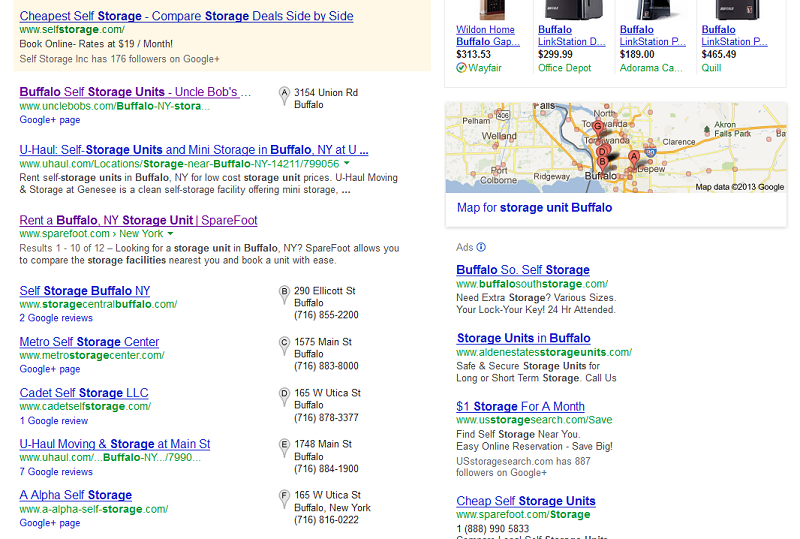Are Google Map Results Changing?
While doing a recent localized search, I noticed an anomaly in the map results interspersed within the regular search results. Now, we’ve all seen the “map packs” – subsets of around seven mini results sans-description with a location, phone number and map pin labeled by a letter that corresponds to the map in the side column.

On this search, however, I saw a result separated. It was the “A” result in the first position without a description. Then two organic listings before eventually reaching the rest of the map pack results.
This is quite an interesting departure. Typically, the unclebobs.com result is first. However, that position customarily comes with a description and even additional site links. While the result is still the first position, it’s simply a stripped down map location.
With the smaller space, shoved right between the ads – is this going to hurt the first position’s status? Are eyes destined to simply gloss it over with the shorter screen real estate?
This is likely another UI test from Google. Interestingly, most of these tests Google performs are designed to determine if the result in the top-spot is relevant enough to warrant the top spot. The idea is that if if continues to garner the same amount of clicks it deserves to be there. If not, well, the algorithm perhaps it should be pushed lower.
But without a description, how would a searcher know?


I have been looking for apartments in the Bay Area constantly (every day) for 3+ months. I peel the address off craigslist, go to Google Maps (or just click on Google Maps link), and do Directions to subway, coffee, supermarket, etc., and then hit ” Did you mean a different: BART” to see them all. It worked great. The past 2 weeks the results have degraded, as follows: (1) the distance of the search results now indicates “as-the-crow-flies” distance, as much as 4/10 of a mile difference, once you make a selection — and some places that appear farther away as the crow flies are actually shorter in reality than the ones that appear closer as the crow flies once you click it (it wastes time and is misleading, and distance as the crow flies is irrelevant unless you’re a crow), (2) neighborhoods I’ve already searched dozens of times (so I know roughly, approximately, where the supermarket or coffeeshop is) are omitting search results, or pointing to places ridiculously and unnecessarily far away–right now I’m looking at an apartment on Google Maps and it indicates the closest coffeeshops are 4/10 of a mile away (again, as the crow flies – actually some are 4/10 and some as much as 7/10 of a mile away) and ignoring 2 coffeeshops I know exist closer by (tho I can’t remember where exactly or their names – hence trying to use this tool). Really annoying. I am going to now have to use Yelp Map as my go-to tool.
Well, I guess the author, Thom, didn’t think much of my comment one way or another, but I am going to add to the above, for the benefit of other “civilians” who are getting confused or frustrated by Google’s new Map’s algorithm. I continue my hunt for an apartment, and am seeing that the business that are being pointed to are often definitely not by proximity/”closeness,” but by some kind of ranking system (Yelp? or some other consumer site?). So, looking for an apartment, and want to know what businesses I care about are nearby. Plug in restaurants—and 1 month ago, after clicking ” Did you mean a different: Restaurants” it would indicate all the closest restaurants—-and today Google Maps is pulling up restaurants **not on the same block** as the potential apartment, which I found when I visited is surrounded by restaurants that are indexed by google and my google maps, more particularly, but the most expensive, most “highly rated,” restaurants in Berkeley–like Chez Pannise, which is a full 2 miles away, and others of that ilk, while there are literally dozens of other restaurants. As I have said, up until early July Google Maps behaved entirely differently. I also today before looking at a place searched for coffee, and Google Maps indicated there was not one coffee shop (and no supermarket) within 1 mile. There is a coffeeshop basically next door, and a market 2 blocks away. I then plugged in the coffeeshop by name for “directions,” and then redid the search for coffee — and NOW it “learned” I want close coffee shops, and gave me an entirely different set that it had before I was able to tell it to look in closer proximity. That’s really impractical.
Swiss:
I’ve been traveling a great deal the past two weeks and apologize if my reply was not as timely.
As far as your comment goes, it’s barely on point with my post’s observation that the results were different. If you want to use Yelp as your go-to map tool, great. My post was not about the Google Maps algorithm. Nor am I a brand advocate for Google Maps. I was simply talking about map results within organic search appearing in a different manner than I had seen before.
However, regarding Maps, your observations make sense. While the “as the crow flies” argument rings true, it’s difficult to program something like what you’re asking. It also relies on the apartment owners filling out proper information about their properties. Many – especially independent apartment owners using Craigs List – don’t always put exact addresses in. As such, it’s nearly impossible for Google to determine.
Many business owners are also guilty of not optimizing their sites or claiming their Google Local locations. How many out-of-place pinpoints do you see on Google Maps (or Bing, Yelp, Foursquare, etc)? Bad data exists and it results are predicated upon it.